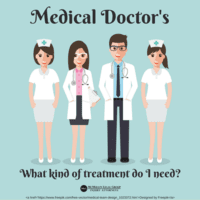Medical Doctor
This article discusses the basics of the medical doctor profession, focusing on the particular types of treatments a medical doctor offers.
What is a medical doctor?
A medical doctor is someone who is a “professional doctorate”, or a doctor of medicine (MD). In order to become a doctor in the United States, one must graduate from an accredited Medical School and pass the United States Medical Licensing Exam, or USMLE. Once the graduate passes the USMLE, they undergo additional specialization called a residency. The graduate usually does their residency in a hospital under the direct or indirect supervision of a practicing physician. If the graduate successfully completes their residency, they can obtain an unrestricted license to practice medicine.
Doctor’s Office, Urgent Care, ER
Calling 911 is the first option for an emergency medical concern, but if you can manage or someone can take you, go to the Emergency Room for life-threatening, acute or extremely urgent situations. Emergency Room (ER) visits can be very expensive, but that is of little relevance if a health concern is an emergency. Urgent care (InstaCare for example) is a good option if the medical concern is urgent, but not an emergency like an ear infection, a sinus infection, the flu, etc.. When someone has a non-urgent health concern, visiting a doctor’s office is recommended.
ER Doctors
When someone visits the ER they are treated first by an ER doctor who helps stabilize them. If that patient needs further medical attention, they will refer the patient to a Trauma Surgeon.
Primary Care
Primary Care doctors usually have office hours similar to normal business hours, like 8-5. Primary care physicians and doctors perform many actions, including but not limited to:
- Check-ups;
- Diagnosis;
- Rehab;
- Direct treatment;
- Monitor and manage health conditions;
- Educate patients; or
- Refer patients to specialists.
Specialist
Primary care doctors help diagnose and treat general illness. If someone has a joint problem they suffer from a knee injury, a primary care doctor might refer that patient to an orthopedic doctor (bone doctor) or rheumatologist (musculoskeletal doctor) for further treatment.
Types of injuries/sickness they treat
The types of injuries/illness a primary care doctor treats can vary from the flu to a broken bone to an ear infection. ER doctors and Trauma Surgeons treat urgent and life-threatening injuries like head-related injuries or injuries with lots of blood loss. A specialist will have a specific practice that treats certain injuries. For example, there are foot and ankle doctors who specialize in the treatment, mobility, and health of the foot and ankle. If someone has an ankle issue and they go to a primary care doctor, that doctor may treat the pain, but more than likely refer them to a specialist for further treatment.
Types of treatment
Surgeons treat patients by manual manipulation of the body with the application of instruments. Primary care doctors focus on treating patients with medicine and educating them for further prevention of illness. Specialists will focus on treatment of a specific area; for example a foot and ankle specialist will focus on treatment through exercises of many kinds and massage therapy, to name a few.



